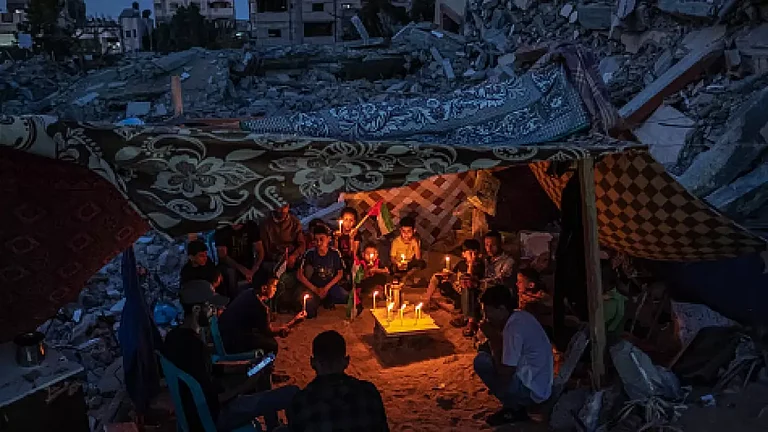She cried feebly and had her umbilical cord still tied to her mother, who was dead. The umbilical cord connected life and death literally. Aya was pulled out alive from the rubble of a home in northern Syria’s rebel-held Jindayris township. The infant is the sole survivor of her immediate family. On February 6, at 4: 17 am local time, an earthquake measuring 7.8 on the Richter scale in magnitude struck southern and central Turkiye and northern and western Syria. As teams of rescuers rushed from Ankara and Istanbul, subsequent aftershocks wrecked more havoc in 10 provinces of Turkiye. In unaffected provinces and cities, people glued to TV sets wore a gloomy look as the death toll began to swell. Social media began to be flooded with videos of death, destruction and an occasional rescue and survival.
The End of History
All the affected cities and townships mostly feature in the food map of foodies and ancient history books. Antakya, the centre of the affected Hatay province, has been destroyed completely. The city was founded in 300 BC with houses in different styles coexisting and competing Abrahamic religions and sects. The fight is now over. The mosque minarets, synagogue pulpits, crucifixes of churches and the tombs of Alawite chapels are now fused together in the rubble. Antakya bitti, translated as ‘Antakya is finished’ is the only expression that survivors in the city are using to describe the devastation. Adana, another city now in ruins, is often scoured by foodies for the famous Adana Kebap. Most of the city has remained hungry and without sleep after the devastating earthquake. The food capital of Turkiye now waits for hovering helicopters to drop food.
Gaziantep has been inhabited since the Neolithic Age. The city is a mutilated mirror image of the Age today. The 2,000-year-old Gaziantep Castle is destroyed to the extent that it seems it was never built by the Romans and the Byzantine Empire. Just a few yards from the Gaziantep Castle stands the 17th-century Sirvani Mosque with its dome shattered completely. Malatya, known for its apricots, can be anything– a cold desert, haunted wreckage or a barren, desolate land. The Yeni Mosque in Malatya, which was also the subject of Kemal Tahir’s 1974 novel Namuscular, has collapsed too. The 17th-century mosque had suffered damage from earthquakes in 1894 and 1964. The historic Diyarbakır Fortress, built in the 6th century BC by King Tigranes of the Orontid Dynasty, located in Diyarbakir province, has collapsed too. The fortress had the longest defensive walls in the world, second only to the Great Wall of China. Sanliurfa, popularly known as Urfa, is the site of the world’s oldest and most mysterious stone temples, the Göbekli Tepe, of the pre-pottery Neolithic Age (9,000–8,500 BCE). Though Urfa is one of the worst-affected provinces, the temple has miraculously survived the ravages of the earthquake as has the Arslantepe Mound in Malatya. In the ancient city of Aleppo, Syria, the famous Aleppo Citadel that was partly damaged in the 2012 Battle of Aleppo during the Syrian civil war, has suffered severe damage. The citadel, which showcases Greek, Roman, Byzantine and Ottoman architecture, lies in ruins. Besides Aleppo, on the List of World Heritage Sites in Danger, several buildings at the World Heritage sites of Diyarbakır Fortress and Hevsel Gardens Cultural Landscape, an important centre of the Roman, Sassanid, Byzantine, Islamic and Ottoman periods, have collapsed.
Rescue: A Herculean Task
Keeping their senses alert while fighting sleep and fatigue, rescuers are drilling through the concrete rubble wherever they are able to hear a sign of life—a gasp of breath, a sigh or a feeble cry. On February 9, five-year-old Hazal Guner was rescued from the wreckage in Hatay after 72 hours. She refused to drink water and innocently asked for a medical check-up first.

However, with the passing of time, the hope of survival for those buried under is becoming bleaker. An occasional successful rescue rejuvenates the hope of survivors looking to be reunited with their kin, even as stories of miraculous escape abound.
On February 12, a child was pulled out in the Nizip district of Gaziantep after 148 hours, another was pulled out after 150 hours in Hatay. Muhammad, 27, was rescued after 140 hours in Kahramanmaras. As he lay under the rubble, rescuers asked him to stay alert and talked to him. He recited the Quran until he was pulled out. A crippled man and two of his family members were pulled out after 115 hours, amid cries of jubilation in Gaziantep. When Sengul, a four-year-old girl, was traced after 132 hours in Gaziantep, she asked her rescuers to give her yellow Coke and that too in plenty, as she lay on a stretcher. Similarly, Abdul Halil, 12, while he lay under the wreckage of his house in Malatya, asked for a simit (Turkish bagel). When he was pulled out, all he did was hug his rescuers, saying, “Merhaba Tasshakur ler” (Hello, thank you very much).
Thirteen-year-old Karim, who too was rescued after 84 hours from underneath an iron bar, was reluctant to come out until his rescuers promised to take him to Besiktas for a football match. In Kahramanmaras, the rescuers communicated with 12-year-old Abdullah through a palm-sized hole until they completed the drilling and pulled him out. A two-year-old girl was still sucking her pacifier when she was extracted unhurt, hours after the earthquake, in the neighbourhood. A 15-year-old deaf and mute boy was rescued unhurt in Hatay after 132 hours. A seven-month-old baby girl was found alive in the arms of her dead sister when rescuers heard her crying in Aleppo. Another man in Kahramanmaras was rescued after 108 hours, when rescuers heard him recite the Quran from beneath the rubble.

Relief Amid the Rising Toll
The death toll in Turkiye rose to 24,617 on February 12, while more than 4,500 were reported killed in Syria. The toll, however, has kept rising steadily since the day the massive earthquake hit. There are households that have been completely wiped out. There are people whose deaths remain unreported as they remain buried under the rubble with no survivors left to look for them. Many Syrian refugees, who had fled the war back home, had inhabited the earthquake-hit areas. It would be a herculean task to trace these people without identification documents.
The colossal tragedy has brought the best out of the citizenry, especially children, who are donating their piggy banks to help the affected. For instance, Agha, a six-year-old boy, came out with 200 Turkish lira, held tightly in his fists, to contribute to the relief efforts in Turkiye. Agha said, “This is what I have saved and this is all I could help.” Many children from Ankara and Istanbul have been writing letters to the survivors and donating their piggy banks to the affected. An 80-year-old woman from Erzurum, who survived the 1983 earthquake, sold a heifer cow, her only possession, for 13,000 Turkish lira and donated the proceeds to earthquake victims. A five-year-old girl from Istanbul, while donating her toys, piggy bank, stationery and story books, penned a small note for survivors: “If you don’t have money, take my piggy bank. If you don’t have a home, come to my home, if you don’t have school, come to my school, if your toys are still under the rubble, play with mine, till we take them out and clean them for you.”

The Turkish Disaster and Emergency Management Presidency (AFAD) is leading rescue efforts. It has more than 6000 staff and had recently trained more than 20,000 civilians in disaster management. The İnsan Hak ve Hürriyetleri (Human Rights and Freedoms–Humanitarian Relief Foundation) is another NGO that has deployed a team of dedicated volunteers on the ground. Haluk Levent, Turkish rock singer, collected donations worth 53 million Turkish lira in crypto currency in a few hours.
It isn’t just the assigned agencies and NGOs that are doing relief and rescue work. Universities are also becoming hubs of relief activity. Staff members and students are busy on all campuses packaging and transporting relief material to the affected areas. Actor Sinan Albayrak’s appeal to mobilise caravans and electricity generators from movie sets to affected areas got a prompt response from the Turkish film fraternity. The largest manufacturer of lighting equipment in Turkiye has sent energy and lighting equipment to rescuers in affected areas. The public broadcaster TRT is functioning as a relief operations centre as well.
However, the calamity has let loose marauders as well. There have been reports of robberies in various cities with the police having arrested as many as 50 offenders. Austrian and German teams have halted their relief work alleging a deteriorating security situation, prompting President Recep Tayyip Erdogan to vow that Turkiye would crack down on elements that disturb law and order. Turkish authorities have begun to arrest contractors of buildings that have collapsed. Many of them have already been arrested while trying to flee the country.
(This appeared in the print edition as "Between Despair & Hope")
Umair Gul is a post-doctoral researcher at Social Sciences University of Ankara






















